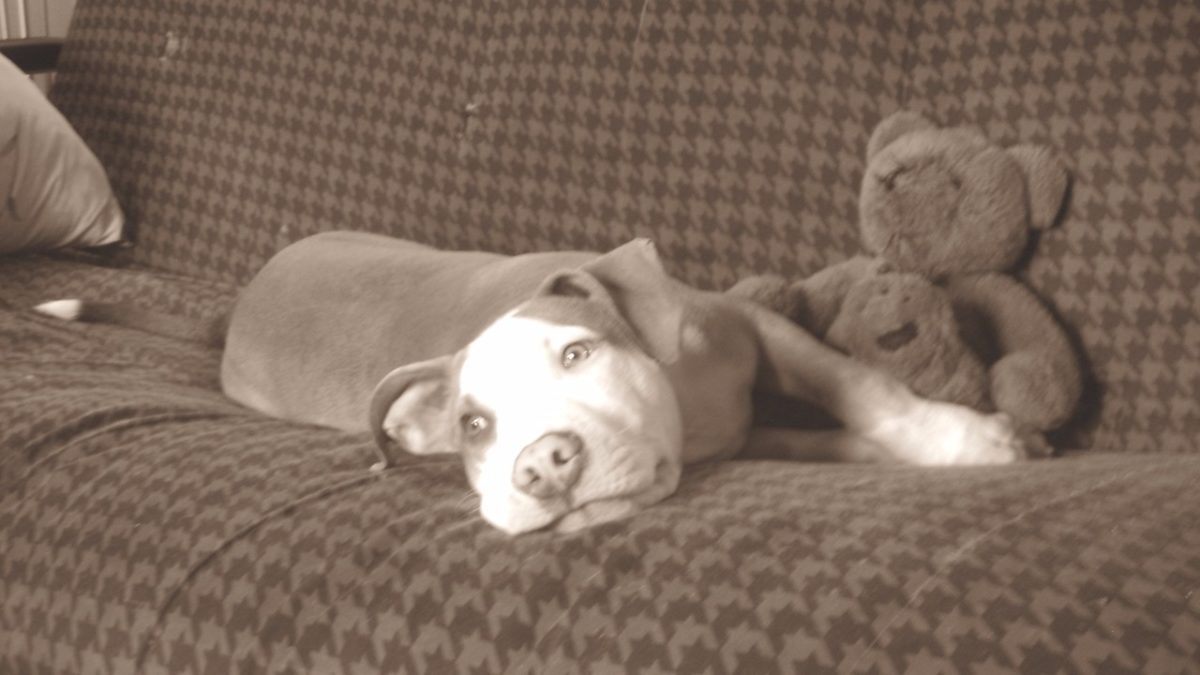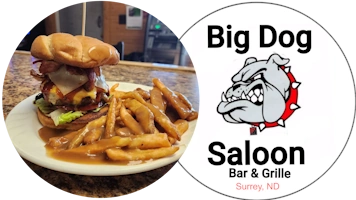What do you think about pit bulls? Are they dangerous or are they just dogs with a bad rap sheet?
I ask because next month City Council will be taking up the question of revising or repealing Minot’s breed-specific-law that makes owning a pit bull in town illegal.
The topic has generated a mountain of community conversation, and like the rest of American politics, there’s no shortage of people on both sides. And from among those passionate minorities (I would characterize those with no opinion as the majority), there seems to be no tolerance for alternative viewpoints.
None of that changes the fact that as a City Council member, I’ve got the job of deciding the issue. Mark your calendars, our meeting is tentatively scheduled for January 17th. Between now and then, I’m going to tease out my current views about pit bulls to see what you think about my thinking and how I’m approaching the issue.
A bit about my bias…
If there’s one thing that’s clear about this issue, it’s that we all have our own stories to tell. I’m no different. So before I tell you about the pitbull-arguments that are resonating with me, it seems appropriate that I share my background with dogs in general.
I’m not a dog owner, but I like dogs. And I love their honesty. I’ve never met a dog that didn’t tell me exactly what he or she thought about me right from the start.
I have one first-hand experience with a pit bull. She was adopted by a friend out of an Interstate-26 ditch near Charleston, SC. She was a sweet, gentle animal, great with kids, and an all around wonderful family pet.
I’ve also lived with a pair of Doberman pinschers. My first experience with those animals was the male hitting a sliding glass door separating us so hard he cracked it. He was outside; I was inside. He was a VERY protective dog — and at that moment he was trying to break through a glass door — I was a stranger in his house. The owner assured me that if I moved in, he would introduce me to the dogs carefully. Once socialized, I would enjoy the comfort of their fiercely protective dispositions.
I ended up moving into the place despite the unnerving first impression.
And while I lived there, I did enjoy the comfort of their protection. But make no mistake, those dogs were dangerous. In return for their protection, we had to be especially careful. We had to be careful with the garage door. We had to be careful with the mailman. We had to be careful with friends and family. Everyone we knew was warned not to ‘pop’ in on us.
The one time we slipped up, a friend got bit. The individual had been to the house before, had been socialized with the dogs. But on that night, he entered the house too quickly. The attack was on and then under our control in an instant. But not before our friend absorbed four painful-looking puncture wounds. Everybody, including the uninjured and the dogs, was shaken by the event.
So, those are my stories. That’s the baggage I’m carrying into the conversation. Pit bulls can be great, loving pets. Dogs of any breed — without a doubt — can be dangerous.
Why a Ban to Begin With?
So where do we go from there? My first stop is public safety. Let’s assume Minot’s current pit bull law was put on the books because a previous City Council viewed the breed as a danger to public safety. As such, they took action in an attempt to protect public safety.
It’s hard to argue with that logic. If we identify a risk, it seems prudent to take steps to minimize exposure to that risk.
But that rests on the assumption that pit bulls are indeed a risk to public safety — so much so that they warrant special attention under the law. This is the assumption that I’ve chosen to question first.
Lies, Damned Lies, and Statistics (Thank you, Mr. Twain)
Are pit bulls dangerous? To answer that, I could rely on statistics. I’ve received no shortage of links to various studies on both ends of that question. Here’s what I’ve discovered — I don’t trust any of the research or statistics. I see flaws in the scientific method. I see media bias. I see research bias. I see politically-driven motivations. In short, I see all sorts of problems with the statistics people show me about pit bulls, so I’ve chosen not to trust any of them.
That leaves me still looking for a way to determine if pit bulls are dangerous dogs. So, like it or not (and I want to hear from you in the comments if my method is flawed), this is the method I’m using this far: I’m basing my conclusion on whether pit bulls are dangerous dogs on the anecdotal answers to two questions.
That’s right; I’m relying on the stories I’ve heard in the news and the stories you all have told me. And these are the questions I’m attempting to answer after hearing your stories. Do pit bulls bite more often than other dogs? When pit bulls do bite, do they do inflict more damage?
Frequency & Degree of Injury
Now, before you jump down my throat, please remember that all I’m attempting to determine right now is, are pit bulls dangerous dogs? Do they represent a risk to public safety?
If yes, then I’m going to move forward with figuring out how to reduce risk to public safety.
If no, then I probably have to think about repealing our current pitbull law because there wasn’t a justified need to ban them in the first place.
Here are my conclusions:
Do pit bulls bite more often than other dogs? From what I’ve heard from all of you and experienced personally, I’m not sure. Let me put that another way. There’s nothing I’ve heard in the news and in the contacts I’ve gotten from citizens that leads me to believe pit bulls bite people more often than any other dog breed. My conclusion: No. I have no reason to believe pit bulls bite people more often than other breeds.
Do pit bulls do more damage when they bite? On this question, I’m willing to say the answer is yes. Again, this based on what I’ve learned from media reports and from the stories you’ve told me. I believe that when compared to dog bites from most other breeds, pit bulls cause more harm and greater injury.
Now, we’re nearing the end of this particular commentary on pit bulls, but I want to assure you I’m not done with the topic. And thus far, I’ve drawn only one conclusion — pit bulls represent a risk to public safety because when they bite people, they tend to do more damage and cause greater injury than many other breeds.
Yes, Pitbulls are Dangerous
Like it or not, that’s where I stand right now. And if pit bulls are a risk to public safety, then I’m willing to say we — as a City Council — should take steps to protect the public from that risk — if we can.
What should we do about that increased risk? I’m not sure yet. Alderman Straight’s committee recommended we adopt a dangerous dog ordinance mirrored after Fargo’s law. What I am sure of is there are a lot of factors to consider.
Part II of me sharing my thoughts on pit bulls will be published later this week. I’m going to jump into the potpourri of arguments and statements people have made to me in hopes of swaying my decision. Is there such a thing as dog racism? Is it the owner or the dog — a rekindling of the ‘nature vs. nurture’ debate. Should I care about the message we (as a community) send to people who are considering moving to Minot? Should we be proactive or reactive? These are just a few of the arguments I’m hearing, and I’m going to touch on all of them.
In the meantime, I’d greatly appreciate you sharing your thoughts on my earlier conclusion. Use the comment forum below, because your voice won’t be heard unless you use it. It takes just a second to get registered, but it’s important. It proves we’re each talking to real, live Minot people.




I would like to see a dangerous animal ordinance of some kind replace the ban. Personally I have never been attacked by a pit but I have by other breeds. Because I cannot drive I am pedestrian more than the average person I probably walk between 300 – 500 miles in a year. While on foot I have been approached by several dogs who are either stray or “on the loose”. Some were friendly some not. The worst was an 80 pound german shepherd blue healer cross. After it attacked and bit me I beat the crap out if it trying to get away and it had no effect what so ever. My overall point is the responsibility is on the owner any breed can be a problem and some are more capable of doing more harm do to their genetic build. We need to reexamine our leash law especially the “under verbal control” portion. Perhaps some breeds need to be on leashes shorter than 6 ft? Maybe some breeds or dogs that have a history are not allowed to be in parks or allowed to meet the “verbal control” part of the ordinance. either way dog owners need to be prepared that citizens have the right to protect themselves as I have seen to many just turn their dogs loose. I say protect themselves because one of the kids who witnessed the german shepherd attack me asked me what I was going todo if it wouldn’t have let me go. I said nothing while putting my knife back in my pocket I think he knew I was going to kill it if it attacked again, a car drove up and it ran away.
Leif, thanks for sharing your thoughts and your stories. I think a citizen would always have a right to protect themselves; the concern I have with pit bulls and other large dogs is that protecting oneself may not be possible.
My concern about is about the term “pitbulls”. It is your prerogative to make your decisions as you see fit but I would say that a “pitbull” doesn’t exist. When classifying these breeds more often than not we are talking about a dog that is mixed with several types of dogs and then is labeled as a pitbull. It makes for a generic brand and then is easily used when we don’t truly know a breed. Even our Animal Control Officers cannot agree on which dogs are or are not “pitbulls” and our ordinance gives them the final determination. In this circumstance we could have two different answers to whether or not a dog bite is classified as a “pitbull” attack and thereby further clouding untrustworthy statistics.
My suggestion is that we craft an ordinance that takes the determination of breed out of the equation. If a pet is a hazard to the community it should be marked in a database that allows all first responders to have the knowledge of where these pets live. Your Doberman story is the perfect example. While this dog was likely loved at home it was not great with surprise guests. The database im suggesting would give first responders the knowledge that a potentially hazardous dog lives there and enable them to take precautions if necessary.
I could go on with other circumstances and scenarios but I don’t want to fill your page. I will finish with this, we say that a BSL is a proactive measure that ensures the safety of the community. Grand Forks, Fargo, Bismarck, and numerous smaller towns in North Dakota have all either repealed there ban or did not have a ban to begin with. If these animals are that dangerous, why haven’t we seen a spike in attacks in these areas? If all these cities and towns can make this work, why can’t Minot?
Hi Randy,
Thanks for your comment!
The challenges that come with identifying the breed and thus enforcing the law are not lost on me. That will be a part of the next commentary.
That said, I’m not imposing the ‘pit bull’ language into this discussion. This is the language that’s being shared with me by citizens. This is the language being used in media reports. This is the language in our law. And this is the language that we as a culture are using to discuss a certain type of dog with certain physical characteristics and behavior traits. I am far from a dog expert, but I suspect nearly everyone of us brings to mind an image of a dog when we hear the word ‘pit bull’. Is that a fair or accurate image when speaking purely about breeds? Very likely not.
Personally, I think the ‘pit bull’ language is there to describe the commonalities that exist in each our respective mental images. And the usage of the language has emerged because those commonalities do exist. They aren’t always in perfect alignment, but they are often enough that we can have a conversation.
To your last point, I agree — we need to evaluate the efficacy of our current policy. We need to be honest about whether it’s protecting us or not. Those concerns too will be part of future commentaries.
Respectfully,
Josh Wolsky
Josh I appreciate that you study very carefully issues that come up. But I cannot for the life of me understand how you can come to the conclusion Minot should allow the freedom of these dogs. Instead of reading points of view, just look at a few videos and see the damage these dogs have done. It is a proven fact that the breed has been extremely dangerous. Perhaps you could approach one of these dogs and see what happens. This is not a case of being fair with about 3% of the population Josh. Consider the other 97% who fear these animals.
Hi Jim,
I think you’ve badly misinterpreted my commentary. The only conclusion I’ve shared at this point is that I do believe ‘pit bulls’ represent a danger to the public, and that being the case, it’s appropriate for City Council to take steps to reduce the risk.
The current pit bull ban was an attempt to do just that. And it may well still be a reasonable tool. But it may also be that the policy is only providng us with the illusion of security. If that’s the case, it wouldn’t be the first time well-intentioned government policy fell short of its goals.
I think it’s totally appropriate for City Council to ask the question, “Is our current policy the best we can do?” In future commenatries, I’ll break down the factors that I’m weighing and the direction I’m leaning, but my decision on this issue won’t be made until January 17th when I vote on it.
Respectfully,
Josh Wolsky
While I am an avid dog lover of all breeds I do believe the public needs protected from dangerous animals. If you noticed I did not specify any breed. When returning back from the military service, many years ago, I had to part with my companion dog of 4 years due to this ordinance and I know it currently affects those who get stationed here at MAFB who have to either part with their dog or find a housing outside of Minot.
Any breed can be dangerous if not properly socialized. I truly believe that the owners are responsible for this and if they fail to train and teach there dogs correctly then it should be addressed as a case by case basis.
I understand you have to look at public safety as well so in looking at this ordinance If it changes I hope the wording doesn’t open up more restrictions on breads that are currently allowed within the city limits.
Hi Devin,
Thanks for reading and taking the time to share your thoughts!
Respectfully,
Josh Wolsky
I’m very impressed with your debate method. Calm logical and reassuring all that you are researching the best possible decision for the community as a whole, and I appreciate that greatly! I am biased towards the pitbulls (love them), but I also believe in the wrong environment they can be dangerous (as you stated this is a possibility with any breed) I think the solution would be registering a dog deemed as a dangerous breed, doing background checks on owners and professional behavioral assessments would be a good thing. I don’t believe just anyone should own a pitbull and if the person had a history of abuse (towards either animals or people) they should not be allowed to own what is determined as a dangerous breed. But I also believe pitbulls deserveto have a chance and people that move here shouldn’t be forced to leave behind their fur baby. My point being monitoring…yes. Complete banning based on what an animals bite force is…no. We should also look at the specifics of each situation….was the animal provoked, was it protecting itself/family, etc. It is not black and white and should not be treated as such. Again thank you for taking this matter seriously and being open to hearing everyone’s side.
Hi Kya,
Thanks for taking the time to comment. I appreciate your position, and you’re not alone.
Here’s a bit of a challenge for you to consider: many of your suggestions — behavioral assessments, monitoring, background checks on people and dogs — while they are all likely good ideas that would help reduce the risk of an incident, they’re also likely expensive and time-consuming. That’s yet another challenge that must be balanced against our choice. Our government does not have unlimited resources we can focus on this issue, and every decision we make will come with a trade-off in some other place. Property tax bills are coming out this week, and while many are passionate about pit bulls, I assure you there are more residents concerned about the cost of living in Minot.
Just some things to consider. Again, thanks for sharing your thoughts!
Respectfully,
Josh Wolsky
Hi Josh! Thanks for taking the time to really study and break down each point of this issue. No doubt, whatever decision is made it will be a tough one because you can’t please anyone. If Minot’s main goal is to make our community safe, why are we only just focusing on one breed? The only argument that can be made is that it is being “proactive” by having a BSL law in place. But is it really? I don’t think so. Each animal should be held to a standard and only judged by their actions just like humans are. “Pitbulls” were never bread to inately attack humans, matter of fact no breed ever was, it’s a learned trait. To keep our community safe it makes more sense to have a “dangerous animal” law in place. Can pitbulls be dangerous? Do doubt! But so can any other breed. So, in my opinion, the BSL we have in place currently isn’t really keeping our community safe because the actual dangerous animals (and have proven to be) are still able to freely be in Minot with no stipulations just because they aren’t a pitbull. Also, families who are moved to work on base in Minot a lot of the time have to leave their furry family member behind because of Minot’s current law, so it makes those families not enjoy their time while in Minot. I feel it is time to adopt a law to keep our community safe as a whole just like every other major town in North Dakota. End BSL.
Hi Kenzie!
Thank you for taking the time to share your thoughts. And thank you as well for making articulate arguments! This issue evokes a tremendous amount of passion regardless of which side one is on, and I’ve found it’s a lot easier to listen to those who are willing to project themselves into the position of having to consider both sides and the interests of the larger community. I’ll be updating all these comment threads as I publish my final two commentaries on the matter, they’ll touch extensively on your thoughts because what you’ve outlined are some of the strongest arguments in support of removing Minot’s pit bull ban. Thanks for reading and happy new year!
Josh Wolsky